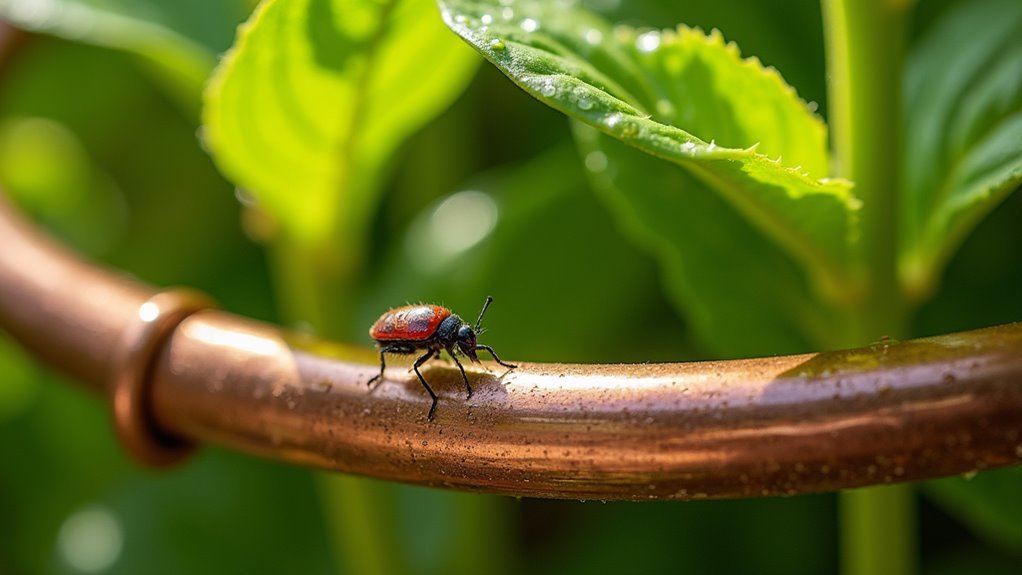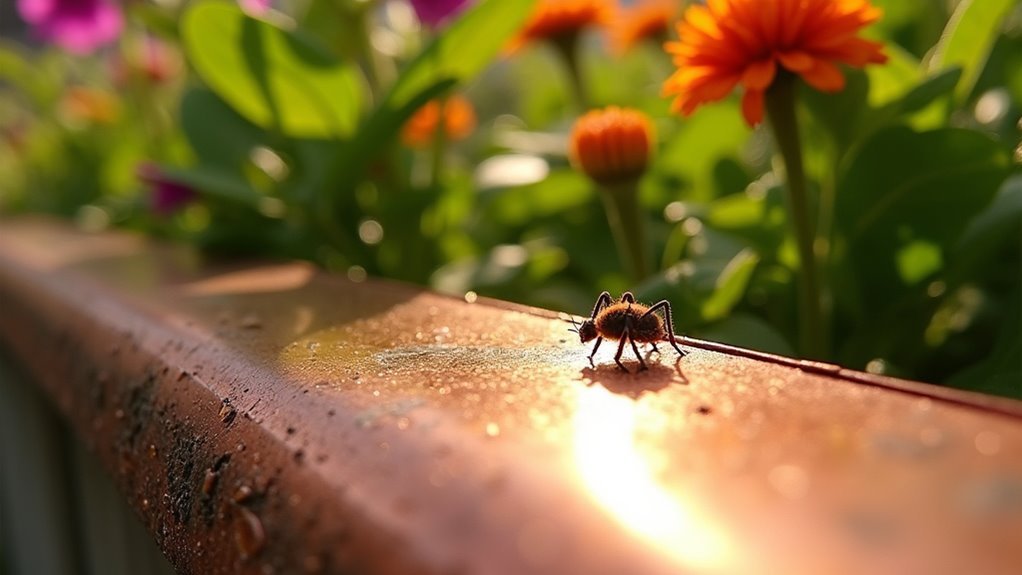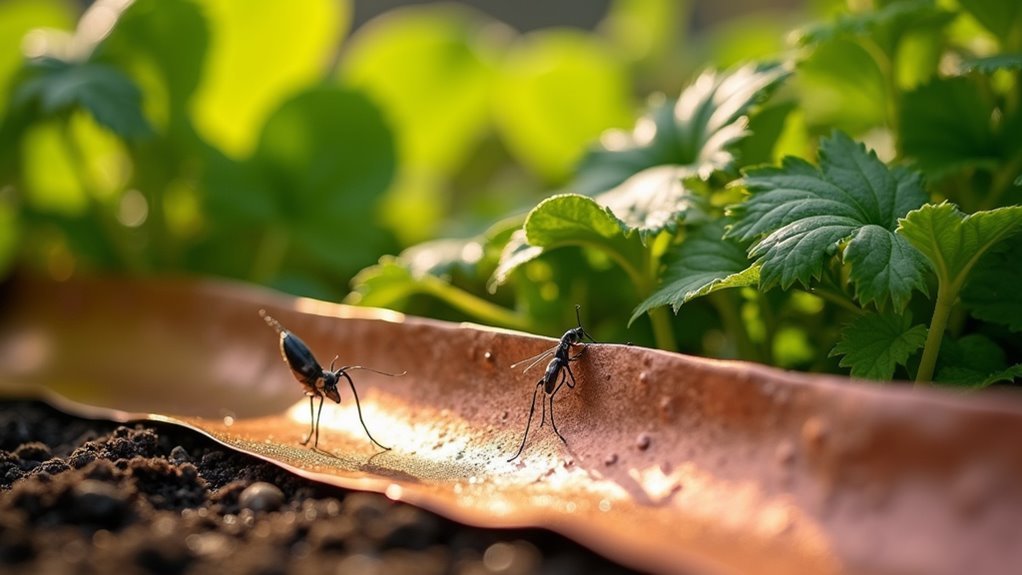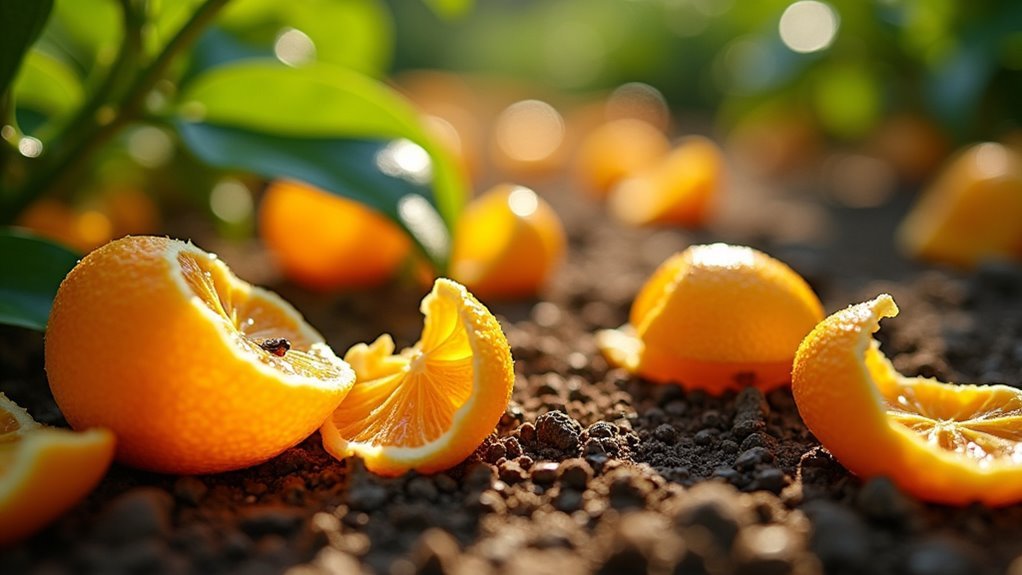Copper barriers effectively stop garden pests because they create a mild electrical charge when slugs and snails contact the metal surface with their conductive slime. This electrical reaction disrupts their nervous systems and causes discomfort, making them turn away from your plants. The copper also interferes with their hemocyanin proteins, which are essential for oxygen transport in their bodies. For best results, you’ll need barriers at least 2-3 inches wide to prevent pests from simply stretching across, and proper installation techniques will maximize your garden’s protection.
The Science Behind Copper’s Pest-Repelling Properties

When slugs and snails encounter copper barriers in your garden, they experience a mild electrical charge that creates immediate discomfort and forces them to retreat. This reaction occurs when their slime trail contacts the copper tape, creating a voltage difference through the interaction between the metal and conductive ions in their mucus.
The electrical disruption interferes with their nervous system, making movement difficult and painful. These mollusks are particularly vulnerable to copper because they rely on hemocyanin proteins for oxygen transport, making them hypersensitive to copper exposure.
The slug and snail deterrent effect depends on proper installation—your copper strips must be wide enough to prevent these pests from stretching across without contact. Narrow barriers won’t provide adequate protection since they can simply bridge the gap.
How Copper Creates an Electric Shock Effect on Slugs and Snails
When you place copper barriers around your plants, the metal interacts chemically with slug and snail slime to create a mild electric shock effect.
The ions in their conductive slime react with the copper surface, generating a voltage difference that disrupts their neurological systems.
This electrical conductivity through their bodies causes enough discomfort to deter these pests from crossing your copper defenses.
Copper-Slime Chemical Reaction
Copper repels slugs and snails through a fascinating electrochemical process that occurs when their mucus contacts the metal surface. When these garden pests encounter copper barriers, their conductive slime triggers an immediate chemical reaction that creates an unpleasant electrical sensation.
The copper-slime interaction follows this process:
- Ion activation – Conductive ions in the mollusk’s mucus react with the copper surface upon contact.
- Voltage creation – This reaction generates a voltage difference across the slug’s or snail’s body.
- Circulatory disruption – The resulting compound interferes with their internal systems, causing significant discomfort.
This electrochemical response makes copper an effective natural deterrent. The electrical charge you’ll create with copper strips causes enough discomfort that slugs actively avoid crossing these barriers, protecting your plants without harmful chemicals.
Electrical Conductivity Through Ions
As slugs and snails glide across surfaces, their mucus contains dissolved salts and electrolytes that act as natural conductors of electricity. When these creatures encounter a copper strip, the ions in their slime create a conductive pathway that allows electrical current to flow. This electrical conductivity generates a small voltage difference that produces an uncomfortable shock, disrupting their nervous system.
| Component | Role | Effect |
|---|---|---|
| Slug mucus | Conductive medium | Creates electrical pathway |
| Copper strip | Conductor | Generates voltage difference |
| Ions | Current carriers | Enable shock transmission |
The wider your copper strip, the more surface contact occurs, intensifying the electrical effect. This bioelectrical reaction causes immediate discomfort, making slugs retreat from copper barriers. You’ll find this natural electrical deterrent works consistently without harming plants or beneficial insects.
Neurological Disruption Process
Beyond creating a simple electrical pathway, the copper-slime interaction triggers a cascade of neurological disruptions that fundamentally alter how slugs and snails process sensory information.
When you install copper tape around your garden beds, you’re basically creating a neurological interference zone that affects these pests’ basic motor functions.
The disruption process occurs through three critical pathways:
- Voltage interference – The electrical charge disrupts neural signal transmission between brain and muscle tissue.
- Hemocyanin sensitivity – Their copper-based respiratory proteins become overwhelmed, affecting oxygen distribution.
- Ion imbalance – Essential electrolyte processes become scrambled, impairing coordination and feeding responses.
This neurological chaos makes crossing copper barriers extremely uncomfortable, establishing effective slug and snail control that relies on their own biology working against them.
Understanding the Biology of Molluscs and Their Copper Sensitivity
When slugs and snails encounter copper, their unique biology creates an immediate defensive response that makes these barriers remarkably effective.
Copper triggers an instant biological alarm in slugs and snails, forcing them to retreat from treated surfaces.
You’ll understand this better by examining their physiological makeup. These molluscs rely on hemocyanin proteins to transport oxygen throughout their bodies, making them particularly vulnerable to copper’s toxic effects.
Their moist, mucus-covered skin contains conductive ions that react with copper surfaces, creating a voltage difference across their bodies. This produces discomfort that deters crossing.
Copper disrupts their circulatory and respiratory systems while causing neurological interference that impairs movement and feeding abilities.
The wider your copper barriers, the more effective they’ll be, as snails and slugs can’t stretch across without making contact with the deterrent surface.
Types of Copper Materials Best Suited for Garden Barriers

You’ll find three main types of copper materials that work effectively as garden barriers against slugs and snails.
Copper wire mesh offers flexible coverage for irregular areas, while solid copper strips provide durable long-term protection around plant beds.
Copper tape presents the easiest installation option, though you’ll need to take into account width requirements and material quality for the best pest deterrence.
Copper Wire Mesh Options
The versatility of copper wire mesh makes it an excellent choice for creating custom-sized barriers that effectively repel slugs and snails from your garden beds.
You can cut this material to fit any garden layout, providing targeted slug and snail control where you need it most.
When selecting copper mesh for your garden, consider these key factors:
- Choose unplated copper materials – Plated versions reduce electrical conductivity that’s essential for pest repelling effectiveness.
- Opt for wider mesh strips – Broader barriers create larger contact zones that slugs and snails struggle to cross.
- Maintain your barriers regularly – Clean oxidation buildup periodically to restore the copper’s pest-deterring properties.
Unlike deteriorating copper strips, mesh screens offer non-degradable, long-lasting protection for your plants.
Solid Copper Strip Applications
While copper mesh provides excellent coverage for larger garden areas, solid copper strips offer precise, targeted protection for individual plants and smaller garden features. You’ll find these strips particularly effective when wrapped as copper tape around individual plant stems or container bases for focused slug and snail control.
| Strip Width | Best Application | Protection Level | Maintenance |
|---|---|---|---|
| 2-3 inches | Small containers | Moderate | Weekly cleaning |
| 4-6 inches | Medium planters | High | Bi-weekly cleaning |
| 6+ inches | Garden beds | Maximum | Monthly cleaning |
| Variable | Custom barriers | Adaptable | As needed |
You must use unplated copper materials to generate the electrical reaction that repels pests when their slime makes contact. Regular cleaning removes oxidation buildup, maintaining conductivity and ensuring your barriers remain effective throughout the growing season.
Copper Tape Installation Methods
Although copper tape offers the same pest-deterrent properties as solid strips, proper installation techniques determine whether your barriers will effectively protect your garden investments. The electrical shock created when slugs and snails contact copper makes this material invaluable for slug and snail control.
Follow these essential steps for ideal copper tape installation:
- Surface Preparation – Clean and dry all surfaces thoroughly before applying tape around pot circumferences or raised bed perimeters to guarantee maximum adhesion.
- Secure Application – Use staples or tacks on rough surfaces to maintain barrier integrity and prevent gaps where pests could penetrate your defenses.
- Width Selection – Choose wider copper tape strips for enhanced effectiveness, as they create larger deterrent zones that pests can’t easily bypass.
Regular monitoring prevents oxidation damage.
Proper Installation Techniques for Maximum Effectiveness

Installing copper barriers properly determines whether these deterrents will successfully protect your plants from slugs and snails.
You’ll need unplated copper tape or wire mesh to create the electrical reaction that deters pests effectively. Position your barriers 4-6 inches high so slugs can’t stretch over without making contact.
Create an unbroken perimeter around plant beds or pots, checking carefully for gaps that allow bypass routes. Remove any “bridges” like overhanging foliage that pests might use to cross over your copper defenses.
Regular maintenance keeps barriers effective. Clean your copper with steel wool or scourers to remove oxidation that reduces conductivity.
This periodic cleaning restores the metal’s repellent properties and guarantees continued protection for your garden.
Essential Width and Placement Requirements for Copper Strips
You’ll need to guarantee your copper strips measure at least 4 inches wide to prevent slugs and snails from stretching across without making contact.
Position these barriers in complete, unbroken circles around your plant beds or containers, eliminating any gaps that pests could exploit.
Mount the strips at strategic heights where nearby surfaces won’t serve as bridges, allowing slugs to bypass your copper defense entirely.
Optimal Strip Width
When selecting copper strips for garden pest control, width becomes the critical factor that determines success or failure of your barrier system.
You’ll need strips that are at least 2 inches wide to effectively deter slugs and snails from crossing your protected areas.
Narrower copper tape simply won’t provide sufficient deterrence, allowing determined pests to navigate across without adequate contact.
The wider surface forces slug and snail bodies to make prolonged contact with the copper, triggering their natural avoidance response.
Consider these width requirements for maximum effectiveness:
- Minimum 2-inch width for basic protection around small plants and containers
- 3-4 inch width for larger garden beds requiring stronger deterrence
- Wider strips for areas with persistent heavy pest pressure
Strategic Placement Techniques
Strategic placement determines whether your copper barriers will successfully protect your garden or become an expensive disappointment.
You’ll need to create an unbroken perimeter around your plant beds or pots, ensuring no gaps exist where pests can slip through. For raised garden beds, attach copper strips directly to the legs to block climbing access routes effectively.
Monitor your barriers regularly for potential bridges that slugs and snails exploit. Overhanging foliage, fallen leaves, or debris can create pathways that allow pests to bypass your copper defenses entirely.
Trim back any plant material touching the ground outside your protected area.
Remember that even small breaks in your copper barrier render the entire system ineffective, so inspect and maintain continuous coverage consistently.
Maintaining Copper Barriers and Preventing Oxidation Issues
Although copper barriers provide excellent protection against slugs and snails, they won’t maintain their effectiveness without proper care. Oxidation buildup can greatly reduce copper tape’s electrical conductivity, diminishing its slug and snail control properties.
To maintain ideal performance:
- Clean regularly – Use scourers or steel wool to remove oxidation buildup and restore the copper’s repellent qualities.
- Monitor for corrosion – Check surfaces frequently for thick copper oxide layers that reduce effectiveness.
- Choose unplated copper – Unplated options resist corrosion better than plated alternatives and maintain repellent properties longer.
You’ll also need to secure barriers properly, preventing gaps that pests might exploit.
Replace deteriorated copper periodically, especially when exposed to moisture and acidic soil conditions that accelerate deterioration.
Common Plants That Benefit Most From Copper Protection
Certain garden plants face constant threats from slugs and snails, making them prime candidates for copper barrier protection. Hostas top this list due to their tender leaves that gastropods devour quickly. You’ll want to encircle these shade perennials with copper tape to prevent significant damage.
Basil plants also benefit tremendously from copper protection. These culinary herbs’ soft foliage attracts hungry slugs that can destroy entire plants overnight. Installing copper barriers around your basil guarantees you’ll have fresh herbs for cooking.
Strawberry plants need copper protection to safeguard both foliage and fruit. Slugs target ripening berries, ruining your harvest.
Strategic placement of copper strips or mesh around strawberry beds provides effective slug and snail control while promoting healthier growth and better yields for these vulnerable garden favorites.
Combining Copper Barriers With Other Natural Pest Control Methods
While copper barriers provide excellent standalone protection for your vulnerable plants, you’ll achieve even better results by combining them with other natural pest control methods.
Combining copper barriers with other natural pest control methods creates a more comprehensive and effective defense system for your garden.
Creating a multi-layered defense system maximizes your slug and snail control effectiveness while maintaining an eco-friendly garden approach.
- Physical removal and copper tape integration – Use handpicking methods at night with a flashlight while maintaining copper tape barriers around plant perimeters for thorough protection.
- Natural repellent layering – Incorporate crushed eggshells or diatomaceous earth alongside copper strips to create multiple deterrent zones that enhance soil health.
- Environmental management – Pair copper barriers with moisture control by reducing watering during peak feeding times, making your garden less attractive to moisture-dependent pests.
Cost-Effectiveness Compared to Chemical Pesticides
When you’re evaluating pest control options for your garden, the financial benefits of copper barriers become clear through their superior long-term value proposition.
While you’ll pay more upfront for copper materials, you’ll save considerably over time since they don’t require frequent reapplication like chemical pesticides. This cost-effectiveness becomes even more apparent when you consider that chemical treatments need regular repurchasing and reapplication.
You’ll also benefit from copper barriers being environmentally friendly, eliminating health risks to your pets, children, and wildlife.
Unlike chemical pesticides that lose effectiveness as pests develop resistance, copper barriers maintain consistent performance indefinitely. This means you won’t need to purchase additional pest control products, making copper barriers the smart financial choice for sustainable garden management.
Troubleshooting When Copper Barriers Fail to Work
Despite copper barriers’ proven effectiveness, you might occasionally find slugs and snails still reaching your plants. When your copper tape isn’t delivering the slug and snail control you expected, several issues could be undermining its performance.
Even the most effective copper barriers can sometimes fail to keep persistent slugs and snails away from your garden plants.
Check these common failure points:
- Width and continuity problems – Confirm your copper strips are wide enough that pests can’t stretch over them, and verify there aren’t any gaps in your barrier where they can sneak through.
- Surface contamination – Clean oxidized or moisture-filmed copper with steel wool to restore its electrical charge and repellent properties.
- Pest adaptation – Combine copper barriers with other management strategies, as some slugs may develop tolerance over time.
Frequently Asked Questions
What Does Putting Copper Wire in Your Garden Do?
Copper wire in your garden creates a barrier that repels slugs and snails. When they contact the copper, it triggers an unpleasant electric shock through their mucus, causing them to avoid crossing it.
What Does Copper Do for Your Garden?
You’ll find copper provides essential nutrients for plant growth while creating natural pest barriers. It deters slugs and snails through mild electrical reactions, offering eco-friendly protection without harming beneficial wildlife or requiring toxic chemicals.
Does Copper Mesh Really Deter Slugs?
Yes, copper mesh does deter slugs effectively. When you place it around plants, their slime reacts with copper, creating an uncomfortable electrical charge that makes them avoid crossing the barrier completely.
Does Copper Deter Garden Pests?
You’ll find copper effectively deters garden pests like slugs and snails. It creates electrical reactions with their slime, causing discomfort that makes them avoid crossing copper barriers around your plants.
In Summary
You’ve now got the knowledge to protect your garden using copper barriers effectively. Remember to keep your copper clean and position it correctly around vulnerable plants. Don’t rely solely on copper – combine it with other natural methods for best results. When properly installed and maintained, copper barriers offer an eco-friendly, cost-effective solution that’ll keep slugs and snails away from your prized plants without harmful chemicals.





Leave a Reply